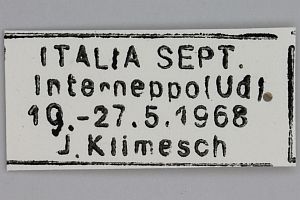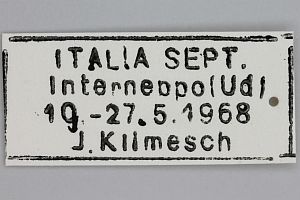

 +15Kontinente:EU
+15Kontinente:EU1. Lebendfotos
1.1. Falter
2. Diagnose
2.1. Geschlecht nicht bestimmt
2.2. Erstbeschreibung
3. Biologie
3.1. Nahrung der Raupe
- [Violaceae:] Viola tricolor ssp. curtisii [= Viola curtisii] (Sand-Stiefmütterchen)
Die Raupennahrung dieser Art war lange unbekannt. Koster & Sinev (2003) können über eigene Beobachtungen berichten: "Host plant: Viola curtisii (Forst.). The larva feeds in June and July, first mining in the petiole of a leave and often making a blotch mine inside the leaf; later it sceletonizes the upper side of the leaf. Sometimes the larva also mines in the flower stalk and causes a long, whitish and rather conspicuous gallery. In last instars the larva bores into the stem, ejecting the frass through the entrance hole; this ochreous or light Brown frass in a leaf-axil indicates the presence of a larva. At this stage, the epidermis of the stem is eaten, causing the plant to shrivel. The feeding area is surrounded by a light web, in which the larva moves quickly forwards and backwards in its silken galleries. Later these galleries reach into the ground, where the bark of the roots is eaten ... (Koster, pers. obs.)"
Falls es sich bestätigt, würden sich P. nodosella durch das Anlegen von Blattminen von Pancalia leuwenhoekella und Pancalia schwarzella unterscheiden. Das Sand-Stiefmütterchen kann nicht die einzige Nahrungspflanze von P. nodosella sein, da es z.B. in Deutschland und Österreich fehlt; wahrscheinlich sind dort also andere Unterarten von Viola tricolor (Wildes Stiefmütterchen) beteiligt.
(Autor: Erwin Rennwald)
4. Weitere Informationen
4.1. Andere Kombinationen
- Oecophora nodosella Bruand, 1850 [Originalkombination]
4.2. Synonyme
- Oecophora nodosella Mann, 1854
4.3. Faunistik
Nach Gaedike (2008: 25) kommt die Art in Deutschland, Brandenburg vor.
4.4. Publikationsjahr der Erstbeschreibung
Viette (1977) konnte zeigen, dass der Teilband mit der Erstpublikation spätestens am 12. März 1851 publiziert wurde. Er lieferte aber keinen Anhaltspunkt dafür, dass das auf dem Band abgedruckte Publikationsjahr "1850" für den Jahrgang 1849 unzutreffend ist. Wie auch schon Sobczyk (2011) sehen wir daher keinen zwingenden Grund, das Publikationsjahr "1850" in "[1851]" abzuändern.
(Autoren: Erwin Rennwald & Jürgen Rodeland)
4.5. Literatur
- Erstbeschreibung: Bruand, T. (1850): Catalogue du Doubs (suite). Tinéides. — Mémoires de la Société libre d'émulation du Doubs 3 (3), livraisons 5-6: 23-69. Besançon (Outhenin-Chalandre fils).
- Gaedike, R. (2008): Nachträge und Korrekturen zu: Verzeichnis der Schmetterlinge Deutschlands (Microlepidoptera). — Entomologische Nachrichten und Berichte 52 (1): 9-49.
- Koster, S. J. C. & S. Yu. Sinev (2003): Momphidae, Batrachedridae, Stathmopodidae, Agonoxenidae, Cosmopterigidae, Chrysopeleiidae. — In: Huemer, P., Karsholt, O. & L. Lyneborg [ed.]: Microlepidoptera of Europe 5: 1-387. Stenstrup (Apollo Books).
- Sobczyk, T. (2011): Psychidae. World Catalogue of Insects 10. — 467 S.; Stenstrup (Apollo Books).
- Viette, P. (1977): Le catalogue des lépidoptères du Doubs de Théophile Bruand. — Bulletin mensuel de la Société linnéenne de Lyon 46 (8): 283-288 [PDF auf linneenne-lyon.org].
























